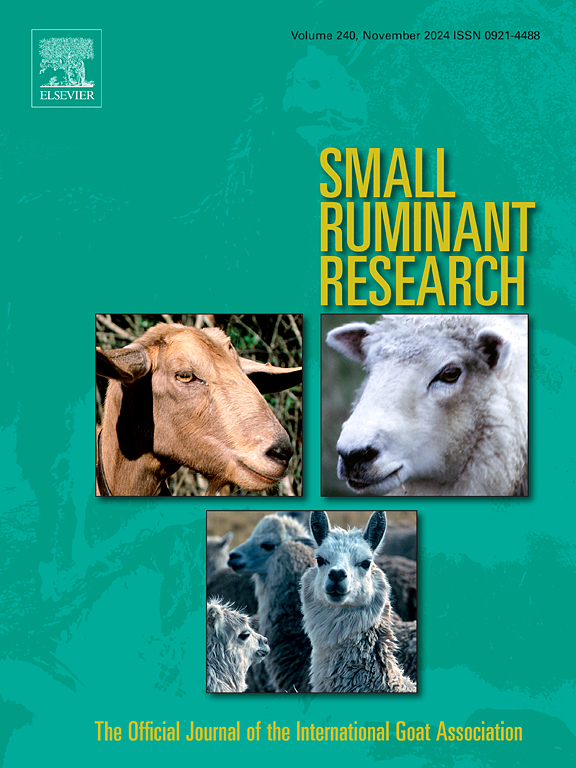妊娠期限饲和过饲对多代绵羊初乳和乳成分及后代循环免疫球蛋白G浓度的影响
IF 1.4
3区 农林科学
Q2 AGRICULTURE, DAIRY & ANIMAL SCIENCE
引用次数: 0
摘要
高质量的初乳和乳汁对新生儿生长和免疫系统发育至关重要。免疫球蛋白G (IgG)是羊初乳中的主要抗体,在被动免疫转移中起着至关重要的作用。尚不清楚妊娠期间母亲营养不良是否会影响几代人的初乳和乳成分以及IgG浓度。我们假设妊娠期母亲营养不良(限饲或过度喂养)会改变F0和F1初乳、乳成分和初乳中IgG浓度,并改变F1和F2后代血清IgG。怀孕双胞胎的多产多塞特母羊(n = 46)饲喂100% %(对照;N = 13),60 %(受限;N = 17)或140 %(超过;n = 16)的国家研究委员会(NRC)的要求,直到分娩。产羔后,泌乳期饲喂100% % NRC需要量。这些母羊的后代(n = 85;F1)按100% %的NRC要求进行类似的管理,与坝饲粮相对应,称为CON-F1、RES-F1或OVER-F1。F1母羊后代(n = 36)在16 ~ 19月龄之间繁殖。这些母羊的后代(n = 60;F2)按100% %的NRC要求进行类似的管理,称为CON-F2、RES-F2或OVER-F2,与祖母日粮相对应。F0和F1母羊在分娩后24 h内采集初乳样品,产后3 d和21 d采集乳样品,分析总固体、粗脂肪、粗蛋白质(初乳和乳)和IgG浓度(仅初乳)。分别于7日龄采集F1和F2子代血清,检测IgG浓度。F0粗脂肪存在时间互作处理(P ≤ 0.024),限饲母羊初乳脂肪含量低于对照母羊初乳。然而,d 3和21牛奶样品的总脂肪在不同处理下是相似的。初乳在第3天和第21天的总固形物、粗脂肪和粗蛋白质含量均高于乳(P ≤ 0.01)。母体日粮对F0和F1母羊初乳IgG浓度无影响(P ≥ 0.46)。雌雄互作对F1子代血清IgG浓度有显著影响(P = 0.007),RES-F1和OVER-F1母羊、CON-F1和OVER-F1母羊血清IgG浓度比CON-F1母羊低44.9 ~ 50.7 %。饲粮对F2子代血清IgG浓度无影响(P = 0.40)。本试验中,饲粮对初乳F0和F1、乳成分及IgG浓度的影响极小。然而,母亲的饮食可能会以性别和饮食特异性的方式限制F1后代对IgG的吸收,但不会持续到F2代。本文章由计算机程序翻译,如有差异,请以英文原文为准。
Effects of restricted- and over-feeding during gestation on colostrum and milk composition and offspring circulating immunoglobulin G concentrations in multiple generations of sheep
High-quality colostrum and milk are critical for neonatal growth and immune system development. Immunoglobulin G (IgG), the predominant antibody in colostrum, is vital for passive immune transfer in sheep. It is unknown if poor maternal nutrition during gestation influences colostrum and milk composition, and IgG concentrations over multiple generations. We hypothesized that poor maternal nutrition (restricted- or over-feeding) during gestation would alter F0 and F1 colostrum and milk composition and IgG concentrations in their colostrum and alter serum IgG in F1 and F2 offspring. Multiparous Dorset ewes (n = 46) pregnant with twins were fed 100 % (control; n = 13), 60 % (restricted; n = 17) or 140 % (over; n = 16) of National Research Council (NRC) requirements until parturition. Following lambing, all dams were fed 100 % NRC requirements during lactation. Offspring of these ewes (n = 85; F1) were managed similarly on 100 % of NRC requirements and are referred to as CON-F1, RES-F1, or OVER-F1, corresponding with dam diet. F1 ewe offspring (n = 36) were bred between 16 and 19 mo of age. Offspring of these ewes (n = 60; F2) were managed similarly on 100 % of NRC requirements and are referred to as CON-F2, RES-F2, or OVER-F2, corresponding with granddam diet. Colostrum samples from F0 and F1 ewes were collected within 24 h of parturition and milk samples were collected at d 3 and 21 postpartum and analyzed for total solids, crude fat, crude protein (colostrum and milk), and IgG concentrations (colostrum only). Serum samples were collected from F1 and F2 offspring at 7 d of age and analyzed for IgG concentrations. A treatment by time interaction (P ≤ 0.024) was observed for F0 crude fat where colostrum from restricted-fed ewes had less fat than colostrum from control-fed ewes. However, total fat in d 3 and 21 milk samples were similar across treatments. Colostrum had greater total solids, crude fat, and crude protein compared with milk at d 3 and d 21 (P ≤ 0.01). Maternal diet had no impact on IgG concentrations in F0 or F1 ewe colostrum (P ≥ 0.46). A treatment by sex interaction (P = 0.007) was observed for F1 offspring serum IgG concentrations where RES-F1 and OVER-F1 ewes and CON-F1 and OVER-F1 rams had between 44.9 – 50.7 % less IgG than CON-F1 ewes. No impact of maternal diet was observed on F2 offspring serum concentration of IgG (P = 0.40). In this experiment, maternal diet had minimal effects on F0 and F1 colostrum and milk composition or IgG concentrations. However, maternal diet may limit IgG absorption in F1 offspring in a sex- and diet-specific manner but does not persist into the F2 generation.
求助全文
通过发布文献求助,成功后即可免费获取论文全文。
去求助
来源期刊

Small Ruminant Research
农林科学-奶制品与动物科学
CiteScore
3.10
自引率
11.10%
发文量
210
审稿时长
12.5 weeks
期刊介绍:
Small Ruminant Research publishes original, basic and applied research articles, technical notes, and review articles on research relating to goats, sheep, deer, the New World camelids llama, alpaca, vicuna and guanaco, and the Old World camels.
Topics covered include nutrition, physiology, anatomy, genetics, microbiology, ethology, product technology, socio-economics, management, sustainability and environment, veterinary medicine and husbandry engineering.
 求助内容:
求助内容: 应助结果提醒方式:
应助结果提醒方式:


